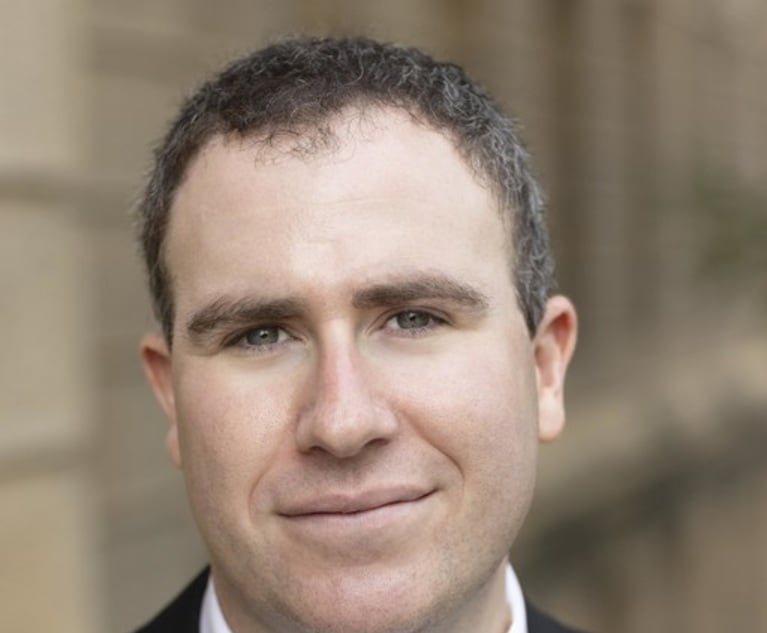The Slow Expansion of Conversion Claims To Cover Intangible Property
While a claim of conversion has grown to extend beyond tangible property to keep up with computerized use, courts are still grappling with how far to extend the tort. In their Commercial Division Update, Thomas J. Hall and Judith A. Archer explore the expansion of conversion claims to cover intangible property.
February 20, 2020 at 12:45 PM
10 minute read
 Thomas J. Hall and Judith A. Archer
Thomas J. Hall and Judith A. Archer
The tort of conversion arises from the exercise of dominion over, and the exclusion of, a lawful owners' rights of possession of their property. Conversion historically involved tangible personal property. With the increasing prevalence of property and technology that is intangible but just as real and valuable as tangible property, an issue arising with increasing frequency in commercial litigation is whether such intangible property can be the subject of a conversion claim. While the traditional view is that it cannot, case law recently has provided some exceptions. Notably, conversion can protect intangible property where it is manifested in some physical form. We explore below this expansion of conversion claims to cover intangible property.
Tort of Conversion
Under New York law, conversion is defined as the "unauthorized assumption and exercise of the right of ownership over goods belonging to another to the exclusion of the owner's rights." State v. Seventh Regiment Fund, 98 N.Y.2d 249 (2002) (citation and internal quotation marks omitted). The Court of Appeals has stated that there are two key elements of conversion: "(1) plaintiff's possessory right or interest in the property and (2) defendant's dominion over the property or interference with it, in derogation of plaintiff's rights." Pappas v. Tzolis, 20 N.Y.3d 228 (2012).
Conversion traditionally involves interference with, or misappropriation of, tangible personal property. In describing the history of conversion, the Court of Appeals in Thyroff v. Nationwide Mut. Ins. Co., 8 N.Y.3d 283, (2007), explained that conversion historically was associated with crimes involving interference with tangible property, such as robbery, larceny, trespass, and trover, "because tangible property could be lost or stolen." The court noted that, historically, real property and intangible property could not be "lost or found" under the law, and therefore could not be remedied by a conversion claim. Over time, as new forms of property surfaced, the common law evolved and courts started to allow conversion claims for intangible property that could be "united with a tangible object," known as the "merger test," and included property such as stock certificates, promissory notes or other papers of value.
Beyond the Merger Test
The Court of Appeals expanded the availabilities of conversion claims for intangible property in Thyroff in 2007. In Thyroff, the plaintiff was an insurance agent who, as part of his agreement with the defendant company, leased computer hardware and software to help facilitate the transfer of information to the defendant company. In addition to customer information, the plaintiff used the defendant's system for personal email and correspondence. When the defendant company terminated the plaintiff's contract, the company restricted the plaintiff's access to the leased computer and electronic records, and thus the plaintiff was unable to access his customer or personal information.
The plaintiff brought a claim for conversion in the U.S. District Court for the Western District of New York, and the trial court dismissed the conversion claim on the defendant's motion to dismiss for failure to state a cause of action. In the plaintiff's appeal to the Second Circuit, the Second Circuit certified the question of whether the conversion of electronic data was cognizable under New York law to the New York Court of Appeals. In deciding for the plaintiff, the Court of Appeals held that "the tort of conversion must keep pace with the contemporary realities of widespread computer use. We therefore … hold that the type of data that Nationwide allegedly took possession of—electronic records that were stored on a computer and were indistinguishable from printed documents—is subject to a claim of conversion in New York." The court further noted that the virtual documents in question could easily be made into tangible documents by the press of a print button, and that it is not the "physical nature of the document that determines its worth, but the information memorialized that has intrinsic value." The court made a comparison to a manuscript having the same value regardless of whether it was in a computer's memory or printed on paper, stating "[i]n the absence of a significant difference in the value of information, the protections of the law should apply equally to both forms—physical and virtual."
Physical Manifestation Still the Norm
Commercial Division courts examining Thyroff have grappled with whether and how far to extend its holding. While the Thyroff court provided protection to the intangible property at issue, it limited its holding to the facts there, stating "we do not consider whether any of the myriad other forms of virtual information should be protected by the tort." Even with Thyroff's expansion, Commercial Division courts have been hesitant to extend conversion to intangible property without a physical manifestation of that property.
In Hyperlync Technologies v. Verizon Sourcing, 2016 WL 642721 (N.Y. Co. Feb. 17, 2016), the plaintiff software company sued Verizon for allegedly disclosing trade secret information and intellectual property surrounding a phone app to a competitor of plaintiff. Among other causes of action, the plaintiff asserted a claim for conversion. Justice Saliann Scarpulla of the New York County Commercial Division examined Thyroff and noted that court's protections of physical and virtual property, but also recognized the Thyroff court (1) limited the decisions to its facts, and (2) dealt with electronic records that were indistinguishable from print records. In dismissing the conversion claim, Justice Scarpulla found that the plaintiffs did not allege conversion of a tangible piece of property, rather the claim was for "intellectual property."
More recently, in Alrai Naked Opportunity v. Naked Brand Group, 2019 NY Slip Op. 33241(U), 2019 WL 5595157 (N.Y. Co. Oct. 30, 2019), two intimate apparel companies merged, and the shareholders of the original companies were issued shares of the merged entity. Prior to the merger, the plaintiff purchased shares in one of the entities from a non-party vendor. The deed of sale provided that if the plaintiff received less than 9.6 million shares of the merged entity, the non-party vendor who sold the shares would provide additional shares to plaintiff for no consideration. Certain circumstances diluted the percentage of shares that plaintiff received. The plaintiff alleged that his shares were converted to over 1.48 million shares of the merged entity, to which he asserted he had legal ownership, but that the merged entity directed that only 1.17 million shares would be registered in plaintiff's name. The plaintiff alleged conversion of its shares by the merged entity, claiming the company exercised dominion and control of roughly 300,000 shares. The plaintiff also alleged conversion of its "right to receive additional shares" based on his beneficial interest pursuant to its third-party agreement. Justice O. Peter Sherwood of the New York County Commercial Division recognized Thyroff for the proposition that conversion of intangible property may be considered tangible where the plaintiff has a physical representation of that property, or where electronic records are indistinguishable from printed documents. The court, however, dismissed the conversion claim, finding a physical manifestation necessary and that the plaintiff had failed to allege that it possessed any share certificates "or any other physical manifestation of the allegedly converted shares."
Exclusion or Deprivation of Property
While the Thyroff decision expanded conversion in that instance to electronic data, the court did not directly address whether the element of exclusion was still necessary to a conversion claim involving electronic data. Until Thyroff, precedent was clear that exclusion was necessary for conversion. In Seventh Regiment Fund, decided before Thyroff, the Court of Appeals stressed that "[s]ome affirmative act—asportation by the defendant or another person, denial of access to the rightful owner or assertion to the owner of a claim on the goods, sale or other commercial exploitation of the goods by the defendant—has always been an element of conversion."
Following the Thyroff decision, while the majority of decisions deem exclusion as still necessary, one Commercial Division case took the position that Thyroff "suggested that [a] plaintiff may maintain an action for conversion where its electronically stored data is misappropriated, regardless of whether plaintiff has been excluded from access to its intangible property." In that case, New York Racing Ass'n v. Nassau Reg'l Off-Track Betting, 29 Misc.3d 539 (Nassau Co. 2010), the New York Racing Association (NYRA) and its president sought to recover for unauthorized live transmissions of audio-visual simulcasts of NYRA races on defendant's website during a 53-day period. Justice Stephen Bucaria of the Nassau County Commercial Division found that, even though the plaintiff was not excluded from the live transmissions, it relied on Thyroff's view of the "intrinsic value" of the property as opposed to the "physical nature," and thus allowed a conversion claim to proceed.
Subsequent Commercial Division cases have declined to follow the New York Racing Assn. rationale. Justice Eileen Bransten of the New York County Commercial Division directly addressed that decision in Jones Group v. Zamarra, 2014 NY Slip Op. 31448(U), 2014 WL 2472102 (N.Y. Co. April 9, 2014), in which the plaintiff alleged that three former employees, and their new employer, misappropriated and transferred proprietary and confidential business information that belonged to the plaintiff. The plaintiff's argument relied on the interpretation of Thyroff advanced in New York Racing Assn., arguing that intangible property, such as computer files, was subject to an action for conversion regardless of whether plaintiff was excluded from it. The court in essence disagreed with New York Racing Assn., and found that Thyroff did not suggest exclusion was no longer necessary, because the facts of Thyroff involved a plaintiff who was actually deprived of his property. Thus, the court found that the facts in Jones Group were not in accord with Thyroff, and that deprivation or exclusion was still a necessary component of conversion. Because the plaintiff did not allege such deprivation, the court dismissed the claim.
Similarly, in MLB Advanced Media, L.P. v. Big League Analysis, 2017 NY Slip Op. 32617(U), 2017 WL 6450546 (N.Y. Co. Dec. 18, 2017), Justice Shirley Werner Kornreich of the New York County Commercial Division found no conversion claim existed over the use of trade secret information, where the information contained in a binder was returned to the counterclaim plaintiff. The court examined Thyroff and concluded that no court has "abrogate[d] the rule that a defendant who, though having custody of goods, does not exclude the owner from the exercise of his rights is not liable for conversion."
Conclusion
While a claim of conversion has grown to extend beyond tangible property to keep up with computerized use, courts are still grappling with how far to extend the tort. Courts have been careful not to confuse conversion with other torts involving misappropriation, and appear hesitant to change exactly what the cause of action seeks to protect. Whether intangible property is protected is very fact-specific, and more often than not a physical manifestation of the property is required. Further, to be successful, the underlying facts of a claim likely still must support that the plaintiff's right of possession was interfered with to the degree of deprivation and exclusion. Nevertheless, continuing technological advancement and changes to the nature of personal property surely will challenge these criteria in years to come.
Thomas J. Hall and Judith A. Archer are partners with Norton Rose Fulbright US. Max Kellogg, a Norton Rose Fulbright associate, assisted in the preparation of this article.
This content has been archived. It is available through our partners, LexisNexis® and Bloomberg Law.
To view this content, please continue to their sites.
Not a Lexis Subscriber?
Subscribe Now
Not a Bloomberg Law Subscriber?
Subscribe Now
NOT FOR REPRINT
© 2025 ALM Global, LLC, All Rights Reserved. Request academic re-use from www.copyright.com. All other uses, submit a request to [email protected]. For more information visit Asset & Logo Licensing.
You Might Like
View All
Shifting Sands: May a Court Properly Order the Sale of the Marital Residence During a Divorce’s Pendency?
9 minute read
Tortious Interference With a Contract; Retaliatory Eviction Defense; Illegal Lockout: This Week in Scott Mollen’s Realty Law Digest


Court of Appeals Provides Comfort to Land Use Litigants Through the Relation Back Doctrine
8 minute readLaw Firms Mentioned
Trending Stories
- 1The New Rules of AI: Part 2—Designing and Implementing Governance Programs
- 2Plaintiffs Attorneys Awarded $113K on $1 Judgment in Noise Ordinance Dispute
- 3As Litigation Finance Industry Matures, Links With Insurance Tighten
- 4The Gold Standard: Remembering Judge Jeffrey Alker Meyer
- 5NJ Supreme Court Clarifies Affidavit of Merit Requirement for Doctor With Dual Specialties
Who Got The Work
J. Brugh Lower of Gibbons has entered an appearance for industrial equipment supplier Devco Corporation in a pending trademark infringement lawsuit. The suit, accusing the defendant of selling knock-off Graco products, was filed Dec. 18 in New Jersey District Court by Rivkin Radler on behalf of Graco Inc. and Graco Minnesota. The case, assigned to U.S. District Judge Zahid N. Quraishi, is 3:24-cv-11294, Graco Inc. et al v. Devco Corporation.
Who Got The Work
Rebecca Maller-Stein and Kent A. Yalowitz of Arnold & Porter Kaye Scholer have entered their appearances for Hanaco Venture Capital and its executives, Lior Prosor and David Frankel, in a pending securities lawsuit. The action, filed on Dec. 24 in New York Southern District Court by Zell, Aron & Co. on behalf of Goldeneye Advisors, accuses the defendants of negligently and fraudulently managing the plaintiff's $1 million investment. The case, assigned to U.S. District Judge Vernon S. Broderick, is 1:24-cv-09918, Goldeneye Advisors, LLC v. Hanaco Venture Capital, Ltd. et al.
Who Got The Work
Attorneys from A&O Shearman has stepped in as defense counsel for Toronto-Dominion Bank and other defendants in a pending securities class action. The suit, filed Dec. 11 in New York Southern District Court by Bleichmar Fonti & Auld, accuses the defendants of concealing the bank's 'pervasive' deficiencies in regards to its compliance with the Bank Secrecy Act and the quality of its anti-money laundering controls. The case, assigned to U.S. District Judge Arun Subramanian, is 1:24-cv-09445, Gonzalez v. The Toronto-Dominion Bank et al.
Who Got The Work
Crown Castle International, a Pennsylvania company providing shared communications infrastructure, has turned to Luke D. Wolf of Gordon Rees Scully Mansukhani to fend off a pending breach-of-contract lawsuit. The court action, filed Nov. 25 in Michigan Eastern District Court by Hooper Hathaway PC on behalf of The Town Residences LLC, accuses Crown Castle of failing to transfer approximately $30,000 in utility payments from T-Mobile in breach of a roof-top lease and assignment agreement. The case, assigned to U.S. District Judge Susan K. Declercq, is 2:24-cv-13131, The Town Residences LLC v. T-Mobile US, Inc. et al.
Who Got The Work
Wilfred P. Coronato and Daniel M. Schwartz of McCarter & English have stepped in as defense counsel to Electrolux Home Products Inc. in a pending product liability lawsuit. The court action, filed Nov. 26 in New York Eastern District Court by Poulos Lopiccolo PC and Nagel Rice LLP on behalf of David Stern, alleges that the defendant's refrigerators’ drawers and shelving repeatedly break and fall apart within months after purchase. The case, assigned to U.S. District Judge Joan M. Azrack, is 2:24-cv-08204, Stern v. Electrolux Home Products, Inc.
Featured Firms
Law Offices of Gary Martin Hays & Associates, P.C.
(470) 294-1674
Law Offices of Mark E. Salomone
(857) 444-6468
Smith & Hassler
(713) 739-1250






